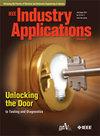Fault Diagnosis of Electric Motors by a Channel-Wise Regulated CNN and Differential of STFT
IF 4.2
2区 工程技术
Q2 ENGINEERING, ELECTRICAL & ELECTRONIC
引用次数: 0
Abstract
In various applications, the reliable and efficient detection of faults in electric machines is crucial, particularly in environments with high noise levels. To this end, the current study introduces an effective fault detection model utilizing the differential of Short-Time Fourier Transform (STFT) and a channel-wise regulated Convolutional Neural Network (CNN). The novel use of the differential of STFT is presented to enhance the diagnostic model's performance in noisy conditions compared with the conventional STFT. According to the inherent time-frequency domain information within the differential of STFT, a regulated CNN-based model is proposed to integrate spatio-temporal information into the feature map, thereby enhancing accuracy and reducing the computational demand. The method is evaluated on three datasets: the widely used Case Western Reserve University (CWRU) benchmark featuring bearing fault and vibration measurements, a dataset involving Permanent Magnet Synchronous Motor (PMSM) data with varying levels of Inter-Turn Short-Circuit (ITSC) fault and current measurements, and a dataset consisting of a mixture of mechanical and electrical faults. Comparative analysis highlights the superior performance of the proposed model over existing robust methods in the literature under both normal and noisy conditions.基于通道可调CNN和STFT差分的电机故障诊断
在各种应用中,可靠和高效的电机故障检测至关重要,特别是在高噪声水平的环境中。为此,本研究引入了一种有效的故障检测模型,该模型利用短时傅里叶变换(STFT)的微分和信道调节卷积神经网络(CNN)。与传统的STFT相比,提出了一种新的STFT差分方法来提高诊断模型在噪声条件下的性能。根据STFT差分中固有的时频域信息,提出了一种基于cnn的调节模型,将时空信息整合到特征映射中,从而提高了精度,减少了计算量。该方法在三个数据集上进行了评估:广泛使用的凯斯西储大学(CWRU)基准数据,包括轴承故障和振动测量,涉及永磁同步电机(PMSM)数据的不同级别的匝间短路(ITSC)故障和电流测量,以及由机械和电气故障混合组成的数据集。对比分析表明,在正常和噪声条件下,所提出的模型优于文献中现有的鲁棒方法。
本文章由计算机程序翻译,如有差异,请以英文原文为准。
求助全文
约1分钟内获得全文
求助全文
来源期刊

IEEE Transactions on Industry Applications
工程技术-工程:电子与电气
CiteScore
9.90
自引率
9.10%
发文量
747
审稿时长
3.3 months
期刊介绍:
The scope of the IEEE Transactions on Industry Applications includes all scope items of the IEEE Industry Applications Society, that is, the advancement of the theory and practice of electrical and electronic engineering in the development, design, manufacture, and application of electrical systems, apparatus, devices, and controls to the processes and equipment of industry and commerce; the promotion of safe, reliable, and economic installations; industry leadership in energy conservation and environmental, health, and safety issues; the creation of voluntary engineering standards and recommended practices; and the professional development of its membership.
 求助内容:
求助内容: 应助结果提醒方式:
应助结果提醒方式:


